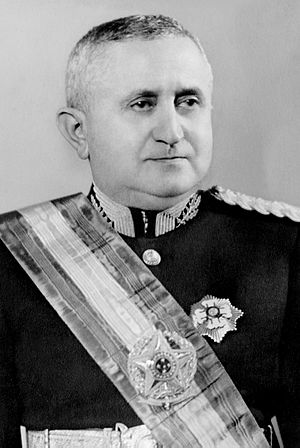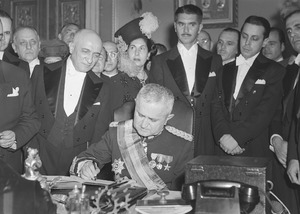Eurico Gaspar Dutra facts for kids
Quick facts for kids
His Excellency Marshal
Eurico Gaspar Dutra
|
|
|---|---|
 |
|
| President of Brazil | |
| In office January 31, 1946 – January 30, 1951 |
|
| Vice President | Nereu Ramos |
| Preceded by | José Linhares (interim) |
| Succeeded by | Getúlio Vargas |
| Minister of War | |
| In office December 5, 1936 – August 3, 1945 |
|
| President | Getúlio Vargas |
| Preceded by | Ribeiro Filho |
| Succeeded by | Góis Monteiro |
| Personal details | |
| Born | May 18, 1883 Cuiabá, Mato Grosso, Empire of Brazil |
| Died | June 11, 1974 (aged 91) Rio de Janeiro, Guanabara, Brazil |
| Political party | Social Democratic Party |
| Spouses | Carmela Teles Leite (m. 1914–1947); her death |
| Children | Emília Antônio |
| Profession | Military, politician |
| Signature | |
| Military service | |
| Allegiance | |
| Branch/service | |
| Years of service | 1922–1974 |
| Rank | |
| Commands | 1st Military Region (1935–1936) |
Eurico Gaspar Dutra (May 18, 1883 – June 11, 1974) was a Brazilian military leader and politician. He served as the President of Brazil from 1946 to 1951. He was the first president of the Fourth Brazilian Republic, which began right after the Vargas government.
Contents
Biography
Eurico Gaspar Dutra was born in Cuiabá, Mato Grosso. He joined the Army and studied at several military schools. He attended the Preparatory and Tactical School in Rio Grande do Sul from 1902 to 1904. He also studied at the Military Academy of Brazil in Rio de Janeiro.
In 1904, he was involved in a student protest related to the Vaccine Revolt. He was briefly expelled but later allowed to return. He finished his studies in 1906. He also went to the School of War in Porto Alegre and the School of Artillery and Engineering. There, he learned about mechanics and ballistics. In 1922, he graduated first in his class from the School of General Staff.
Dutra helped start the National Defense magazine in 1918. He fought against several uprisings in Brazil. These included the "18 Fort" uprising in Rio de Janeiro in 1922. He also helped stop an uprising in Manaus that spread to Pará.
He fought against the Revolution of 1930. After this, he was sent to lead the 11th Cavalry Independent Regiment in Ponta Porã.
Dutra was promoted to colonel. He took command of the 4th Cavalry Divisional Regiment from 1931 to 1933. During this time, he fought in the Constitutionalist Revolution in São Paulo in 1932. He also helped deal with a communist movement in 1935. This event was known as the “Intentona Comunista.” After this, he became the Minister of War from 1936 to 1945.
Minister of War
During World War II, Dutra was one of the military leaders who did not want Brazil to get too involved in the war. However, Brazil did join the Allies and took part in the war.
As people in Brazil pushed for more democracy, Dutra agreed that the government that started in 1930 should end. He helped remove Getúlio Vargas from power in October 1945. Dutra continued the military's strong role in the country.
1945 Election
After Vargas was removed, new elections were held. Vargas then announced his support for Dutra. Dutra was the Army's chosen candidate. He ran against Eduardo Gomes, who was the Air Force's candidate.
Presidency
On September 18, 1946, Brazil got its fifth constitution. This marked Brazil's return to democratic rule. Later that year, Dutra's government created the Social Service of Industry (SESI) and Social Service of Commerce (SESC). These organizations helped workers and businesses. The government also created the General Staff, which later became the General Staff of the Armed Forces (EMFA). In the same year, President Dutra ordered all casinos to close and banned gambling in Brazil.
In 1947, Osvaldo Aranha was appointed Brazil's delegate to the United Nations (UN). Dutra's government also banned the Brazilian Communist Party (PCB). They also ended diplomatic relations with the Soviet Union (USSR).
Brazil became closer to the United States. President Harry S. Truman visited Brazil for the Inter-American Conference of Peacekeeping and Security. A special group called the Abbink Mission was formed with the U.S. This group looked at Brazil's economy. They suggested using outside money for the oil industry.
Also in 1947, the Ministry of Labour became more involved in many labor unions. The government continued to control union activities. A rule from March 1946 limited the right to strike.
Dutra's economic policy had two main parts. First, it was very open, trying to reduce government control over the economy. But this led to Brazil quickly running out of foreign money because of too many imports. In 1947, with advice from the International Monetary Fund (IMF), the government changed its approach. It started controlling foreign exchange again. This policy made exports harder but encouraged importing machines and equipment. This helped the manufacturing industry grow.
The government also had a plan called the “Salte Plan.” This plan focused on Health, Food, Transportation, and Energy. It aimed to manage public spending and invest in important areas. It started getting money in 1949 but was stopped in 1951. During Dutra's time, Brazil started regularly publishing its Gross domestic product (GDP). The economy grew by an average of 7.6% each year under his leadership.
During Dutra's presidency, construction began on the Paulo Afonso hydroelectric plant in Bahia. Work also started on the President Dutra highway, which connects Rio to São Paulo. In October 1948, his government set up the Superior School of War (ESG) with support from the United States.
Later Life
After leaving the presidency, Dutra remained involved in politics. He ran for president again in 1964. However, he faced a difficult election against General Humberto de Alencar Castelo Branco. Dutra received only a small percentage of the votes.
Eurico Gaspar Dutra passed away in Rio de Janeiro on June 11, 1974, at the age of 91. He was buried in the São João Batista Cemetery.
Gallery
1949 state visit to the United States
-
President Dutra and U.S. President Harry S. Truman standing at attention with other dignitaries during welcoming ceremonies for Dutra in Washington, D.C. on May 18.
-
Dutra (in uniform), outside the George Washington home at Mount Vernon, during his visit to the United States.
-
Dutra, Truman, Mrs. Truman and other dignitaries at a state dinner.
See also
 In Spanish: Eurico Gaspar Dutra para niños
In Spanish: Eurico Gaspar Dutra para niños







